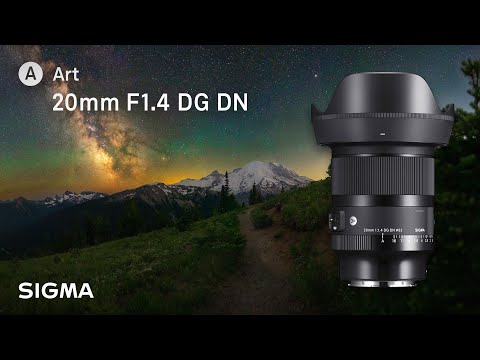Product Description
Sigma 20mm f1.4 DG DN Art Lens for Leica L
- L-Mount Lens/Full Frame Format
- Aperture Range: f1.4 to f16
- Two SLD Elements
- Three Aspherical Elements
- Super Multilayer Coating
- Stepping AF Motor, MFL Switch
- Rounded 11-Blade Diaphragm
- 82mm Front Filter Thread
- Rear Filter Holder
- Durable Brass Bayonet Mount

An ultrawide Leica L-mount prime, the Sigma 20mm f1.4 DG DN Art Lens offers incredible imaging performance from corner to corner, with a large maximum aperture that makes it ideal for use in low-light environments, particularly under dark skies where its new features are especially useful. Always an excellent choice for landscape and architecture, this lens is equipped with newly updated functions especially useful for astrophotographers.

Combining an optical design with in-camera corrections that keep distortion under control, this lens offers an extremely well-controlled sagittal coma flare that yields pin-point stars from edge to edge. Additionally, a new Manual Focus Lock (MFL) switch disables the focus ring, ensuring that focus never changes, even after hours of shooting under chilly, dark skies. The lens has also been developed to accept 82mm front filters, a rarity on ultrawide primes, and another unique feature that includes a rear filter holder, which accommodates sheet filters for various creative effects.

Prime wide-angle 20mm f/1.4 lens is designed for full-frame format Leica L-mount mirrorless cameras and can also be used with APS-C models where it provides a 30mm equivalent focal length.
Fast f/1.4 maximum aperture is well-suited for working in low-light conditions and provides greater control over the focus position when using shallow depth of field techniques.
Two SLD and three aspherical elements have been incorporated within the lens design to correct for chromatic aberrations throughout the entire focusing range and to ensure exceptional clarity and contrast. This optical design also helps to control distortion and limit vignetting.

Employs a concave double-sided aspherical element, which provides outstanding edge-to-edge sharpness and optical performance.
Optimized for astrophotography, the lens offers extremely well-controlled sagittal coma flare and limits ghosting.
A Super Multilayer Coating has been applied to lens elements to minimize lens flare while producing contrast-rich and colour-neutral imagery, even in backlit conditions.
The inner focus system powered by a precise STM stepping motor provides high-speed autofocus and near-silent operation.
Optimized for astrophotography, a new MFL (Manual Focus Lock) switch disables the focus ring, ensuring that focus never changes, even after hours of shooting under chilly, dark skies.
The aperture ring with a click switch and lock switch prevents accidental aperture changes.
A rounded eleven-blade diaphragm helps to produce an attractive out-of-focus quality.

A petal-shaped lens hood helps to reduce lens flare when working in strong lighting conditions and offers some protection to the front element of the lens.
82mm front filter threads and rear filter holder for sheet-type filters.
A curved lip at the front of the lens keeps an optional lens heater from slipping in front of the lens.
Brass bayonet mount for ensured precision and durability.
Compatible with optional UD-11 USB Dock for Leica L, which enables fine-tuning different lens characteristics and updating its firmware.

| Lens construction |
15 elements in 11 groups
|
| Angle of view | 94.5° |
| Number of diaphragm blades |
9 (rounded diaphragm)
|
| Minimum aperture | F16 |
| Minimum focusing distance | 27.6cm |
| Maximum magnification ratio | 1:7.1 |
| Filter thread | N/A |
| Dimensions (diameter x length) |
ø90.7mm × 129.8mm
|
| Weight | 950g |
Payment & Security
Your payment information is processed securely. We do not store credit card details nor have access to your credit card information.
































